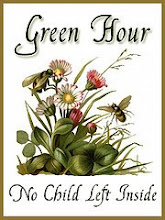

Every early childhood centre I have seen has water play set up. Its one of the few activities (along with sand and swings) that I have seen set up pretty much the same way at Montessori, Waldorf and Playcentre. Usually its a water trough that is set up at toddler height, which is great. Some centres are lucky enough to have water that moves - an old fashioned water pump (which I have seen at a Playcentre next to the sandpit) or a water feature set into a hill ... but an ordinary tap works pretty well too. Wouldn't it be wonderful to have a shallow stream running through your centre ... if health and safety regulations would allow it!
Water play isn't just for the water trough though ... its pretty much everywhere for young children ... pouring a drink, doing the dishes, washing dolls clothes in the laundry tub, washing hands, having a bath, splashing in puddles, collecting rain water, watering the plants, helping Mum and Dad wash the car, at the beach or the swimming pool ... its endless.
At Playcentre there tends to be a lot of 'extension' of water play that involves colouring the water and adding glitter .... or maybe that was just my experience. I'm not sure that's totally necessary - water is amazing enough in its natural state. In the Waldorf context glittery, brightly coloured water is seen as quite harsh on a child's senses. Adding bubbles is great fun though (although you wouldn't see it at Waldorf). What I would say is that adding detergent for bubbles can end up in eyes ... keep the lux flakes for messy play. In the water trough no more tears shampoo is a better idea. Oh, and please keep the water luke warm ... cold water is not great for littlies, especially in winter. photocredit:fran
photocredit:fran
There are lots of ways to extend water play beyond the obvious - a few that I have seen work really well are:
- Put a large hunk of ice in a water trough or large washing bowl. (hardware stores often sell really large washing bowls ideal for home water play) Provide some spatulas or metal spoons to 'chip' away at the ice, and containers of water to pour over the ice as it melts.
- Set up places for children to create their own streams with rocks, grass and perhaps some plastic sheeting underneath. A hose can make this really great fun.
- Set up an old fashioned washing board for dolls clothes, complete with scrubbing brushes and soap.
- A fantastic activity I have seen at Playcentre was stringing up old milk bottles on a line for children to pour water into - all ages seemed to really enjoy this.
- Give children large paintbrushes (industrial type ones) and let them paint with water - stones, wooden pailings, concrete paths.
- Older children can help make little walnut boats - take a half walnut shell and use blu-tack or modelling beeswax to insert a toothpick and stick on a sail made from felt or heavy paper. See if they will 'sail' and make wind by blowing on them.
Another activity often suggested for water play is seeing which objects float or sink. Here, the approaches between Steiner, Montessori and Playcentre are all actually fairly similar, and yet distinctive. All three approaches caution against 'over intellectualising', or bringing adult consciousness to it. They differ however in the degree to which they apply this.
In Steiner/Waldorf, children would discover this for themselves while playing. The kindergartener wouldn't get terribly involved not wanting to alter the natural course of play, nor to bring an adult 'intellect' into the young child's conscious.
At Playcentre, children would also discover this while playing. The teacher/parent might then suggest 'I wonder what else might float' or 'hey, look that one is sinking'. Gwen Somerset then suggests giving children a bunch of different objects and asking them to guess what will float/sink and why. She goes on to say 'young children, unde 7, have little understanding of what causes one objecct to float and another to sink, but the objective is not to supply facts, but to keep children wondering about a problem'. Gwen Somerset, Vital Play in Early Childhood.
In Montesori, the approach is well outlined here by Susan Stephenson "One experiment usually found in 3-6 classrooms is called simply "sink and float." For this experiment, we have a tray containing a box of objects, a vinyl mat or small towel to work on, a clear glass bowl, a pitcher for bringing water to fill the bowl, a bucket for taking the water to the sink when the work is finished, and a small cloth for drying everything when the experiment is finished. We show the child how to carefully place one object into the water, and to observe if it sinks or floats. We make one group, on one side of the bowl of those objects which sink and another, on the other side, objects which float. We do not talk or explain this phenomenon from an adult point of view, we give no labels or language, but let the child ponder, and repeat the experiment whenever she is interested. It is not uncommon for the child to carry out the activity, carefully dry everything, repeat and repeat these steps, as a deep and private understanding of the physics principle grows in her. It is only after the child has had some experience that we introduce the terms "sink" and "float" if the child does not know them yet.
Theory aside, how we as parents react to our children will probably have less to do with our chosen pedagogy, and more to do with our own interests, personalities, and of course, habits! I can't think of anything worse than rushing to a textbook everytime Munchkin discovers something new ... but I do find all these different ideas fascinating. I hope you do too!
I would love any comments with other ideas for Water Play .. I'm sure we all have days when we desperately need some play inspiration!






9 comments:
I am a monressorian so come at it unashamedly from that direction. We certainly do have the sink and float out on the shelves, but when a child shows interest in it we extend it in all sorts of ways. Any experiment you can think of can be introduced to a 3-6 year old child if it is presented in the right way. Last year we made baots out of all sorts of materials and worked out which floated the best. We found out which boats carried loads the best. We went outside and made waterways with guttering and poured water down to see if we could float boats down.
Children are constantly asking questions and it is our job to give them the wherewith-all to start finding the answers for themselves.
Also in the montessori classroom are may activities that involve water somehow - pouring on the practical life shelf, cleaning the tables, washing clothes or cloths, making snack, making an island and pouring in the water in the geography area, mixing coloured water to make new colours in the sensorial area, putting out cut flowers in the classroom or watering the plants in the garden, mopping the floors after an accident......
Actually the water table isn't traditionally montessoian and many purist don't like them because there are so many other oportunities to usefully and creatively play with it. However, here in the UK we have to have it in our classroom s up to 5 years old by law!
Just found you and really like your style!!!
I find there's nothing like an hour long bubble bath with lots of toys for my girls on a challenging at home day :) At our playcentre, we do lots with ice in summer time - freezing objects (petals and flowers etc) in ice, letting kids break up the ice with hammers (probably not very Steiner friendly), freezing ice in ring tins and then tying it up over the water trough and letting it melt. Winter time there's warm water in a small trough, bathing babies, washing dishes ...and of course many of the other suggestions you have here.
There is something about water for littlies, but I do think we need to remember how precious and life-giving a resource water is and how lucky we are to have it readily available here in wet and wonderful Auckland. Something I know I have not done a very good job of instilling in my children so far!
Oh goodie goodie! Just discovered your blog and am so glad I have. Will be a familiar visitor I think!
My girl LOVES water and I too am amazed what a wonderful, mysterious and functional thing it is. She can work with it quiet happily for a long time - once she focused on pouring it for about 2 hours and she was under 2. Its not uncommon for her to pour and water plants in our garden for 45min - 1hour.
Love the creek idea. Will try it out.
Be back soon.
I just wrote a series of posts about water play on my blog. Annabelle, age 2, loves water and we explored how water takes the shape of its container, helps certain materials to float, and is somewhat sticky.
You can see what we did here:
http://www.greenmamma.org/blog/2009/07/02/days-of-you-and-me-day-3-water-painting/
http://www.greenmamma.org/blog/2009/07/09/days-of-you-and-me-day-9-the-magic-of-water/
http://www.greenmamma.org/blog/2009/07/30/days-of-you-and-me-day-24-its-a-wash/
http://www.greenmamma.org/blog/2009/07/26/days-of-you-and-me-day-21-boats-floats-and-rocks/
http://www.greenmamma.org/blog/2009/07/15/days-of-you-and-me-day-14-ice/
I hope that helps . . . we spent a lot of time playing with water because, as you so wisely pointed out, children have a special affinity for noticing water.
Ooh, and great ideas for more water play too, btw.
I just found your blog through Making of a Montessori Mum and find it very interesting. I really like how you have written about subjects from many different education approaches. I've chosen to use the Montessori Method with my daughter but will incorporate anything that I think will be benificial to us both. Thanks for taking the time to share all of your wonderful ideas, knowledge and opinions!
A great post....Sadie loves painting with the bubbles in the bath onto the wall....it's wonderful to see such imagination from a child when playing with a simple thing.
Hi Gypsy - You have some wonderful ideas here.
Luckily our area isn't in drought at the moment so we can enjoy a little water play too :)
Thanks for visiting! I love the ice idea. I hope you get pictures of that milk bottles on a string because for the life of me, I can't picture it!
I would love to incorporate some Waldorf art into our household and make some Waldorf toys like that walnut boat, but I think I also have a black craft thumb. That phrase is hilarious, by the way!
Water play is wonderful. I like your idea of a shallow stream going through the middle of a classroom. Wouldn't that be fun!
Post a Comment